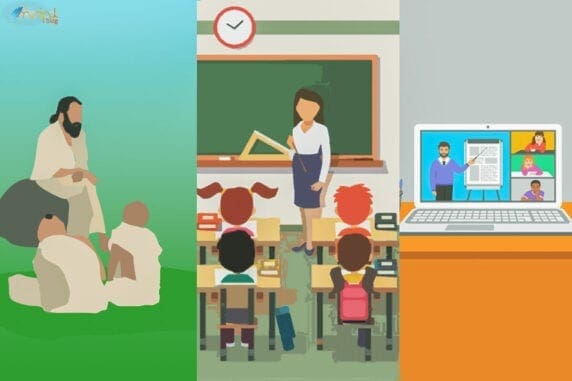
MAHE has decided to impart its college education in dual-mode even if students are on campus!
Education in India has gone through many different phases to stand where it is right now. We have seen major growth in education in the last century. Education in ancient India was given through vocal recitation and training, with no writing instruments involved. After particular grounding had taken place, students opted for streams of their interests and pathshala kind of learning continued.
College Education – Only for the Elite
Around sixty years ago, a college education was considered a privilege that could be taken up only by the elite. Poverty and lack of opportunities deprived students of getting a degree. It was at this time that classroom kind of learning became the norm. But, it was still very limited due to the lack of availability of resources and technology. The student-teacher ratio was very small because the number of students wanting college education was less. This ensured more personal attention to every student.
With the invention of computer technology, college education during the 1990s improved a little with few colleges having a handful of computers. During this period, practical and laboratory forms of education started becoming an important constituent in learning, especially in courses like engineering, medical, architecture, to name a few. The rise of private institutions during this time saw an increase in the number of students acquiring a degree. Through these thirty years, additions have been made to this structure using new inventions to improve the quality and importance of education in India.
College Education Amid the Pandemic
The structure that has been followed for over thirty years had to be replaced overnight due to COVID-19. It has changed the normal way of education. Both teachers and students are learning to adapt to online education – from kindergarten to university. It has provided an opportunity for a teacher to teach more students at one time as no constraint, like classroom sizes that divide a batch of students.

This situation has given leverage to the universities and to the students to have a very flexible way of learning. The students and teachers do not have to worry about being late to class as they can join the online classes from any electronic device.
The lectures being recorded has become a huge advantage for the students. Anybody who is not good at a particular subject or wants to revise and understand a topic better can go back and listen to the recording of that particular class. It also helps that the student can listen to the proper, long explanation of a topic or a question. In a normal classroom, it would have been difficult for the teacher to remember the exact explanation from the first class of that particular topic.
In the future, spending more on the educational budget will aid the government to reach rural villages through online education, and having a large teacher-to-student ratio will help to connect with as many students as possible. This will help children in rural areas to get an opportunity to finish their education with limited teachers because one of the major constraints of education today is the lack of trained faculty in or near these places.
One main indicator of the negative side of online education is that students will miss out on social activities and will not develop social skills because there is no practical interaction taking place. This might cause a problem later on and might lead to the underdevelopment of learning new and social skills. The online classes have also made it hard for the teachers to teach in the traditional way. They have to create more written or typed out content than in the normal way of education.
In any university, campus life plays a very important role to help develop an individual’s character. The extra-curricular activities, student-based clubs, and various events that take place throughout the year help students relax and enjoy college life. They also help to build soft skills and interact with people outside of the student’s stream. All of this has come to a halt which might affect an individual’s character building.
The online education gives restricted scope for practical courses that require more in-class learning. Many professors in courses such as animation, engineering labs, and architecture are facing issues demonstrating and explaining through online classes. The increased distractions during online classes have resulted in reduced attention span among individuals.
College education will never be the same again, but, there is a strong opinion that a mix of online classes and in-campus education could be a reality in the future. There are possibilities of a semester being split into two phases – one for online classes and one for on-campus learning. However, the positive and negative aspects of online education will change when everything goes back to normal.
It can only be observed when universities open up if online classes will be incorporated into the system of learning and how effective it will be.

About the Author – Meghna is a writer based out of Hyderabad. She loves exploring her opportunities but enjoys her alone time as well. She is currently working on improving her content and her writing skills.


Be the first to comment